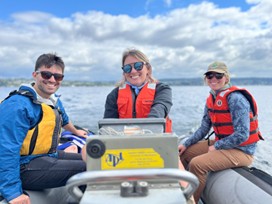The Environmental Health & Safety Boating Safety Program created two new resources to help UW personnel identify and reduce the risk of drowning while working on, over, or alongside water. These resources are designed to prioritize the safety of UW personnel and clarify guidance from Washington State Department of Labor & Industries regarding the selection, use, and maintenance of personal flotation devices (PFDs) to protect workers when drowning hazards exist in the workplace.
What is my responsibility to prevent drowning?
The Personal Flotation Devices Focus Sheet outlines the responsibility that the UW units and supervisors have to evaluate working conditions and activities to determine if a drowning hazard exists, and if so, provide necessary safety equipment, training, and controls to minimize the risk.

Supervisors of UW personnel engaged in research, teaching, or operational activities are required to:
- Identify potential drowning hazards;
- Determine when PFDs are/are not required to be worn;
- Train personnel to properly select, use, and maintain PFDs;
- Identify acceptable types of PFDs to be worn;
- Establish alternate drowning prevention controls; and
- Understand the new Performance Classification System of labeling PFDs, which is replacing the legacy labeling system (Types I-V).
Do I need to wear a PFD?
The Personal Flotation Device Requirements Flowchart determines whether or not a PFD is required to be worn based on the activities that will be conducted, including operating a watercraft (motorized, paddlecraft, or sailboat), entering water while wading or snorkeling, and while working behind guardrails.
What if I have more questions?
Visit the Boating Safety Program webpage for additional information.
Please contact the EH&S Boating Safety Program if you have questions or would like to request a consultation of your activities and PFDs.